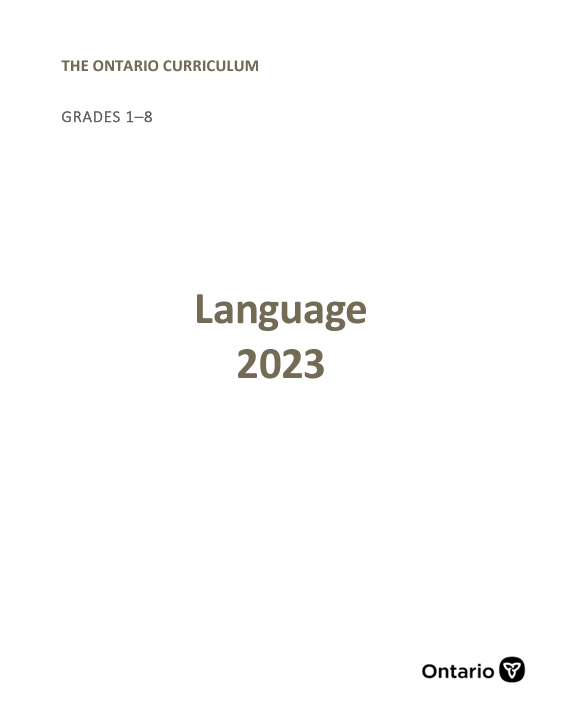Grade 8 Language (English)
Overview of Grade 8 Language (English)
Grade 8 Language (English) Overview (Ontario Curriculum Updated 2023)
The Ontario Curriculum, Grades 1–8: Language, 2023 is designed to ensure that all students develop strong foundational skills in reading, writing, oral communication, and media literacy. The ability to analyze, interpret, and create various forms of text is essential for success in both academic and real-world settings. With a focus on critical thinking, problem-solving, and digital media literacy, this updated curriculum equips students with the tools needed to navigate an increasingly complex world.
In Grade 8 Language (English), students engage with a diverse range of texts, exploring different identities, experiences, and historical perspectives. Learning in this grade integrates the study of:
- Foundations of Language (grammar, vocabulary, spelling, and sentence structure)
- Comprehension (understanding and responding to various texts)
- Composition (expressing ideas and creating written content)
- Literacy Connections and Applications (applying language skills across different subjects and real-life contexts)
By mastering these elements, students build the strong communication skills necessary for success in Grade 9 English and beyond.
The 2023 Curriculum Update: What Has Changed?
Ontario’s Grades 1–8 Language curriculum was modernized in 2023 to emphasize early reading interventions, strengthen digital literacy, and ensure students develop transferable skills applicable in the real world. The last major revision was in 2006, making this a crucial update to better align with contemporary education standards and technological advancements.
What to Expect in Grade 8 English
Grade 8 is a pivotal year for language development, as students refine their reading, writing, speaking, and critical thinking skills. The curriculum prepares them for the greater academic demands of high school while encouraging creativity and independent thinking.
Reading Comprehension
- Students analyze various literary genres, including novels, short stories, poetry, and drama.
- They learn to identify literary devices such as figurative language, symbolism, and point of view.
- Critical thinking is emphasized as students evaluate themes, perspectives, and author intent.
Writing Skills
- Students practice different writing styles, including narrative, persuasive, and expository writing.
- They focus on structuring their ideas, improving grammar, and refining sentence fluency.
- The writing process includes planning, drafting, revising, and editing to enhance clarity and impact.
Oral Communication
- Through presentations, discussions, and debates, students build confidence in speaking clearly and persuasively.
- They learn to use tone, pacing, and body language to enhance their communication.
- Listening skills are also emphasized, encouraging students to engage thoughtfully in conversations.
Media Literacy & Digital Awareness
- Students analyze different media forms, such as advertisements, social media, films, and news articles.
- They learn to identify bias, assess credibility, and understand the societal impact of media.
- Digital literacy skills help students navigate and critically engage with online content.
Preparing for Grade 9 English and Beyond
Grade 8 English is a crucial stepping stone to high school, particularly Grade 9 English, where students tackle more advanced texts, essay writing, and critical analysis. By mastering language skills in Grade 8, students set themselves up for success in academic and applied English courses in high school.
Key areas of focus that transition into Grade 9 include:
- More sophisticated literary analysis of themes and character development.
- Longer, more structured essays with strong thesis statements and evidence-based arguments.
- Advanced vocabulary and grammar skills for professional and academic writing.
- Independent reading and research skills for deeper engagement with texts.
How York Region Tutoring Can Help
At York Region Tutoring, we understand that every student learns at their own pace. Whether they need extra support in reading comprehension, writing mechanics, or oral communication, our expert tutors provide personalized instruction to help students excel.
Our Tutoring Services Include:
- Reading Comprehension Support – Helping students analyze texts, make inferences, and strengthen understanding.
- Writing Development – Guiding students through brainstorming, structuring essays, and refining grammar.
- Speaking & Presentation Coaching – Building confidence in oral communication through structured practice.
- Media Literacy & Critical Thinking – Teaching students to evaluate sources, detect bias, and interpret digital content.
- Preparation for Grade 9 English – Equipping students with the skills needed for success in high school.
Language skills are essential for success not just in school but in all areas of life, from higher education to future careers. By investing in Grade 8 English tutoring, students develop the confidence and ability to communicate effectively, setting the stage for academic success in high school and beyond.
Contact York Region Tutoring today to discover how we can support your child in building a strong foundation in English.
Sources: https://www.dcp.edu.gov.on.ca/en/curriculum/elementary-language/grades/grade-8/home
Grade 8 Language Ontario Curriculum Breakdown (Updated 2023)

Students utilize transferable skills in reading, listening, viewing, writing, and speaking across diverse cultural, social, and linguistic contexts. They learn to articulate their online rights and responsibilities, make informed decisions to enhance their digital identity and reputation, and positively contribute to online communities. Additionally, they demonstrate an understanding of the historical contexts, contributions, lived experiences, and perspectives of diverse individuals and communities, including First Nations, Métis, and Inuit cultures, by analyzing culturally relevant texts.
This knowledge is integrated into the other three areas of the curriculum.
Students assess and apply listening skills and strategies to enhance comprehension and analyze the purpose and audience for speaking. They identify and employ oral and non-verbal communication strategies, including culturally specific variations, and use precise and descriptive word choice, syntax, and grammar in both formal and informal communication. They leverage their knowledge of word meanings for reading and spelling, and apply their understanding of sentence types, grammar, capitalization, and punctuation in reading and writing.
Students analyze and evaluate a range of literary and informational texts, including cultural forms, explaining how their characteristics convey meaning. They examine how visuals like images and graphics contribute to meaning. They analyze elements of style and literary devices, explaining their role in communication. They use comprehension strategies and critical thinking skills to deepen their understanding of diverse perspectives and cultural elements in texts, drawing conclusions. Finally, they assess the effectiveness of their critical thinking skills in text analysis and set goals for improvement.
Students maintain fluency in cursive writing and use advanced word-processing skills to create texts. They generate and develop ideas on challenging topics, synthesizing information and content. They produce complex texts in various forms and genres, establishing a distinct voice and employing varied language, stylistic elements, and tone. They revise and edit their work to enhance accuracy and style, using a variety of techniques and tools, including digital design and production tools, to produce final texts. They publish and present their texts using diverse media and tools.
York Region Tutoring Provides
If a student is approaching a forthcoming test, we can provide them with a previous test to be completed at home before their upcoming session. Subsequently, during their next class, just before the exam, they can review the test with their tutor. These tests are exclusively sourced from high schools in York Region and other areas in Ontario, serving as the definitive benchmark for students to assess their readiness.
York Region Tutors and are equipped with drawing tablets making collaboration simple, efficient and effective. We also offer drawing tablets at a discount for purchase to students who really take to the functionality of the product.
At the parents’ request, following each tutoring session, our tutors can assign homework tailored to address weaknesses and reinforce strengths in students. Additionally, we incorporate homework questions directly extracted from previous tests and quizzes administered by YRDSB school teachers, allowing students to familiarize themselves with potential test questions.

